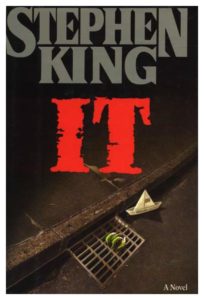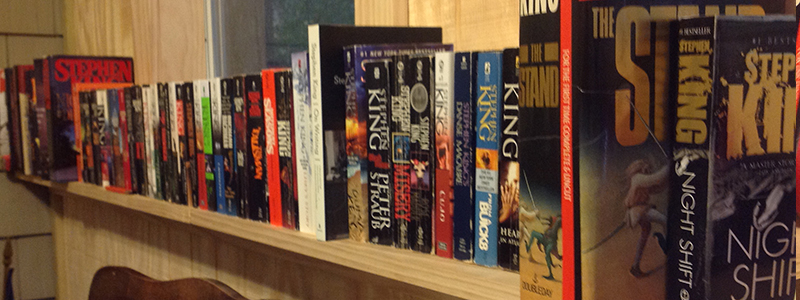by Jay Wilburn
The plan is to reread all of Stephen King’s works in the order that they were published. Richard Chizmar of Cemetery Dance had the vision. I’m doing it because I am a writer and I want to improve my fiction. And I love Stephen King’s stories. I think there is something to be learned through this process.
You can also go back to the beginning and read Before Carrie or any of my other posts up through this one and beyond by checking out this link to the Master List of all my #StephenKingRevisited posts.
Time to remove the masks and face the Dead Lights. Hi Ho, Silver, Away!!!

It may be the most significant book King wrote up to this point in his career. In my opinion, it may have been an unsticking book. I think it may be the book and the way forward he was really looking for when he wrote Danse Macabre.
I started rereading this on Christmas night with copies of Swan Song and Ink Stained waiting to be reread too. That and a number of other new books I threw in between was why it took me this long to finish. I forgot how long Swan Song was. But I finished Skeleton Crew and picked up It again on that day.
Part way through reading, I discovered my dad had read this book at some point. In addition to using a bookmark or turning down the corner of a page, he would use his fingernail to create an indentation mark to show the paragraph he left off on. The first of these I noticed was in the middle of where the creature reaches out to Henry Bowers again. The ghost of his fingernail kept showing back up.
I forgot how well-crafted the prose was in this book, especially at the beginning. This book has a great and iconic opening scene that is played out with a confident, easy pace. One of the quotes I love in this book is “in the end, it is the voice that tells the story more than the stories themselves that matters.” As I get older and read more, I’m starting to buy into this more and more.
There is an imaginary monster discussed that’s all covered in hair and filled with killing spite. It pales in comparison to the real horrors presented in this book. The first mention of “Pennywise” was on page 456. Bob Grey was said well before this. The oppositional force of The Turtle wasn’t mentioned as often or as soon as I remember.
I never really appreciated how often and how personally King writes the relationship between young brothers. The short story “The Monkey” and the novel It both have that quality.
I forgot about the gay couple narrative that followed the Georgie with the paper boat scene. There were a lot of details in this book that slipped my mind or failed to stick with me when I was a much younger reader.
There is a lot of backstory that shouldn’t matter beginning with the gay couple scene. The gay bar they come out of is described to the point that you know the entire interior even though the important scene doesn’t even occur there. You know the history of the place and how it became a gay bar. This is sort of hyper-detailed backstory is repeated with the entire history of Stan’s marriage. Yet, somehow, I’m utterly fascinated with these details. When I shared this personal fact with some friends online, some of them railed against me. I’m an easy mark as a reader for a Stephen King story, I guess.
There are a lot of characters piling up in the opening sections. I’ve read it before and know the story and it is still a lot to keep in my head.
“Nurse us on blood” is a vicious turn of phrase in context and connotation, direct and indirect.
“How much do you remember … Very little. Enough I suppose.” Great lines, character work, and story building. I found the “forgetting” at the other end of the story the most troublesome. Maybe something about getting older and experiencing some forgetting myself makes that a bigger deal to me, but it came with more sadness this time.
“The murders have started again,” is another powerful line.
Directory assistance and a robot voice reading off a number takes me back. There’s a reference to a Clarence Clemons interview for Rich the D.J. and Barbara Mandrel plays on the Jukebox for Ben. Eddie was supposed to drive Al Pacino. The shows Hardcastle & McCormick and Falcon Crest are both referenced. There’s a mention of the O.J. Simpson’s Hertz ad. The service on the various flights is extravagant compared to today. “Like a Virgin” plays on the radio. 404 was the only area code in Georgia in 1985. Much simpler times. Dungeon & Dragons supplies are on clearance. The future of the Warsaw Pact nations is speculated about. Teddy Kennedy and Robert Redford are discussed. The child murders in Atlanta are brought up. Microfiche was the big change in library technology from 1958 to 1985. “Shock the Monkey” by Peter Gabriel shows up to round out the nostalgia moments with what was current when the book was released.
“They believed in Dr. Ruth when they were looking at getting well fucked and Jerry Falwell when looking to get well saved.” This is a very 1980’s line.
A Clive Barker quote from Books of Blood in used in the first interlude.
“Kids don’t make serious promises at eleven.” Another great line with a lot of edge whether you believe it or not. It cuts both ways.
Ben Hascomb lived in Hemingford Home, the home of Mother Abigail from The Stand. Nostrums are mentioned again. King got stuck on this word and concept for a few stories. We get a break with some news articles in the middle of the story. They reference that crazy cop who killed all those women in Castle Rock who appears in the Dead Zone, but is discussed more than once in books after that. A town in Texas where the population is placid from something in the water is mentioned here, for the first time, I think, and becomes the basis of the short story “The End of the Whole Mess” in Nightmares & Dreamscapes. The imaginary tiger reminds me of the odd tiger story in the collection that preceded this novel.
Eddie married a woman who got super fat like his mother. She may be the character that gets one of the rawest deals in the story among those who still live. She and Eddie seem to love and care for each other. No one seems to think to call her after the story is all over to tell her what happened before everyone starts to forget. As far as she knows, her husband left town, didn’t really tell her where he was going, and that’s it. She’s left to wonder what happened. Did he just run out on her?
A coach gives Ben a long and harsh lecture about his being fat being a thing that is in his head. That it is disgusting and self-indulgent.
King seems highly fascinated with women’s nipples in this book.
I remembered the mom freaking out about the X-ray machine in the shoe store. Not sure why that small scene stuck with me. Like the kids from Derry my memories start coming back as I decide to revisit the town. I also remember the scene with Ben looking up the spiral stairs quite vividly.
I remember Beverly’s story the strongest from the beginning introductions of the novel. The way her man treated her. I couldn’t remember if they were married or not. It might have stuck with me because there was sex involved and I was reading it in high school.
The fact that Stan did the cutting for their blood brothers ritual is haunting considering how he was introduced.
The first three boys meeting as kids is really well done for character, action, and story.
Boston is described as “one of the most confusing cities in America to drive in.” I couldn’t agree more.
They compare “It” to the Joker in Batman.
The gun did no good against the monster, but the sneezing powder and the funny voices hurt it.
King puts in a jab about celebrity replacing talent in the latter half of the 20th century. We see where that has gone since.
The conversation in the restaurant reunion scene slipped a little into sounding like a writer writing instead of matching the level of story that led up to this. The decision to walk around the town separately after the restaurant scene serves the plot, but not the motivations of the characters very well.
Interspiritual bleeding is a good term.
I had to stop reading during the domestic violence scene in the middle of the novel. That was heavy. “What mom would want to kill her son with love” was a great closing line to another difficult scene. The infamous sex scene late in the book makes less sense to me in a reread than it did when I first read it.
The making of the silver slugs and Bill’s mom’s perception of the Losers’ Club were so well written.
The kids all take a hit of Eddie’s aspirator. It’s a brief, but strong moment. “This really isn’t a job for kids” is a great line.
The water-stained girly magazines really stuck with me as a horror detail. The horror of a child’s fear on Communion was really strong, too.
Blending the past with the present through the end of the novel was fairly effective.
“Book valium” as a term for reading a specific book for the purpose of going to sleep was funny.
“If an animal’s grunt could have a smell,” is excellent description of something that can’t be described.
In slasher films, when teens have sex, they are in trouble. In Stephen King novels, when husbands have sex, their wives are in trouble. King, in the author notes of “The Mist,” expressed regret at how the husband’s cheating and the wife’s death allowed him to escape without having to face her afterward. I think because of that story, a similar situation in this novel resulted in a different ending.
I’m really glad I reread this novel.
My next post will be Before The Dark Tower book II: The Drawing of the Three which will be linked on the Master List of all my Stephen King Revisited posts.





